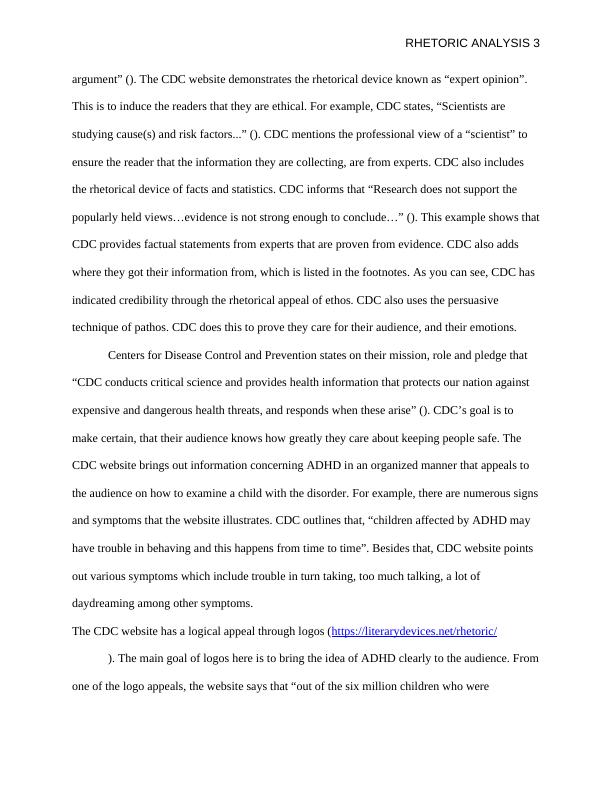Rhetoric Analysis of CDC's Website on ADHD
Added on 2023-06-04
6 Pages1362 Words400 Views
Running head: RHETORIC ANALYSIS
Skylar Van Dam
Your Mom
September 14, 2018
Don’t know
Skylar Van Dam
Your Mom
September 14, 2018
Don’t know

RHETORIC ANALYSIS 2
Rhetorical Analysis
Michael Phelps, an Olympic Swimming champion, is diagnosed with ADHD and is an ADHD
role model. Phelps struggled in school and had a hard time focusing. He had after school
tutors and had to take medication for him to succeed in school. Although Phelps found
school challenging, he used his gift of having extra energy in the pool (). Attention
Deficit Hyperactivity Disorder (ADHD) is not always a burden, but many children suffer
from it in school, due to lack of concentration. A national public health institution called
Centers for Disease Control and Prevention (CDC) works to protect the United States
from health, safety, and security risks. CDC has created a website to purposely inform
society on all health threats. Furthermore, this is to help prevent diseases and to inform
any possible treatments or diagnoses. According to CDC, “ADHD is one of the most
common neurodevelopmental disorders of childhood...Children with ADHD may have
trouble paying attention, controlling impulsive behaviors, or be overly active” (). The
CDC discusses ADHD on their webpage because they find it to be a crucial issue that
both children and adults’ strife with. It is essential for one to confirm that the information
they are obtaining from a public document, is a reliable resource. The rhetoric used in
CDC’s website makes the reader viewing the page feel that CDC is credible. Rhetoric is
“a technique of using language effectively and persuasively in spoken or written form” ().
The CDC utilizes rhetoric adequately to discuss ADHD, by using appeals such as ethos,
pathos, and logos (http://softschools.com/examples/literary_terms/ethos_examples/241/
).
The rhetorical appeal ethos is shown throughout the CDC website. The meaning of ethos
is “when an argument is constructed based on the ethics or credibility of the person making the
Rhetorical Analysis
Michael Phelps, an Olympic Swimming champion, is diagnosed with ADHD and is an ADHD
role model. Phelps struggled in school and had a hard time focusing. He had after school
tutors and had to take medication for him to succeed in school. Although Phelps found
school challenging, he used his gift of having extra energy in the pool (). Attention
Deficit Hyperactivity Disorder (ADHD) is not always a burden, but many children suffer
from it in school, due to lack of concentration. A national public health institution called
Centers for Disease Control and Prevention (CDC) works to protect the United States
from health, safety, and security risks. CDC has created a website to purposely inform
society on all health threats. Furthermore, this is to help prevent diseases and to inform
any possible treatments or diagnoses. According to CDC, “ADHD is one of the most
common neurodevelopmental disorders of childhood...Children with ADHD may have
trouble paying attention, controlling impulsive behaviors, or be overly active” (). The
CDC discusses ADHD on their webpage because they find it to be a crucial issue that
both children and adults’ strife with. It is essential for one to confirm that the information
they are obtaining from a public document, is a reliable resource. The rhetoric used in
CDC’s website makes the reader viewing the page feel that CDC is credible. Rhetoric is
“a technique of using language effectively and persuasively in spoken or written form” ().
The CDC utilizes rhetoric adequately to discuss ADHD, by using appeals such as ethos,
pathos, and logos (http://softschools.com/examples/literary_terms/ethos_examples/241/
).
The rhetorical appeal ethos is shown throughout the CDC website. The meaning of ethos
is “when an argument is constructed based on the ethics or credibility of the person making the

RHETORIC ANALYSIS 3
argument” (). The CDC website demonstrates the rhetorical device known as “expert opinion”.
This is to induce the readers that they are ethical. For example, CDC states, “Scientists are
studying cause(s) and risk factors...” (). CDC mentions the professional view of a “scientist” to
ensure the reader that the information they are collecting, are from experts. CDC also includes
the rhetorical device of facts and statistics. CDC informs that “Research does not support the
popularly held views...evidence is not strong enough to conclude...” (). This example shows that
CDC provides factual statements from experts that are proven from evidence. CDC also adds
where they got their information from, which is listed in the footnotes. As you can see, CDC has
indicated credibility through the rhetorical appeal of ethos. CDC also uses the persuasive
technique of pathos. CDC does this to prove they care for their audience, and their emotions.
Centers for Disease Control and Prevention states on their mission, role and pledge that
“CDC conducts critical science and provides health information that protects our nation against
expensive and dangerous health threats, and responds when these arise” (). CDC’s goal is to
make certain, that their audience knows how greatly they care about keeping people safe. The
CDC website brings out information concerning ADHD in an organized manner that appeals to
the audience on how to examine a child with the disorder. For example, there are numerous signs
and symptoms that the website illustrates. CDC outlines that, “children affected by ADHD may
have trouble in behaving and this happens from time to time”. Besides that, CDC website points
out various symptoms which include trouble in turn taking, too much talking, a lot of
daydreaming among other symptoms.
The CDC website has a logical appeal through logos (https://literarydevices.net/rhetoric/
). The main goal of logos here is to bring the idea of ADHD clearly to the audience. From
one of the logo appeals, the website says that “out of the six million children who were
argument” (). The CDC website demonstrates the rhetorical device known as “expert opinion”.
This is to induce the readers that they are ethical. For example, CDC states, “Scientists are
studying cause(s) and risk factors...” (). CDC mentions the professional view of a “scientist” to
ensure the reader that the information they are collecting, are from experts. CDC also includes
the rhetorical device of facts and statistics. CDC informs that “Research does not support the
popularly held views...evidence is not strong enough to conclude...” (). This example shows that
CDC provides factual statements from experts that are proven from evidence. CDC also adds
where they got their information from, which is listed in the footnotes. As you can see, CDC has
indicated credibility through the rhetorical appeal of ethos. CDC also uses the persuasive
technique of pathos. CDC does this to prove they care for their audience, and their emotions.
Centers for Disease Control and Prevention states on their mission, role and pledge that
“CDC conducts critical science and provides health information that protects our nation against
expensive and dangerous health threats, and responds when these arise” (). CDC’s goal is to
make certain, that their audience knows how greatly they care about keeping people safe. The
CDC website brings out information concerning ADHD in an organized manner that appeals to
the audience on how to examine a child with the disorder. For example, there are numerous signs
and symptoms that the website illustrates. CDC outlines that, “children affected by ADHD may
have trouble in behaving and this happens from time to time”. Besides that, CDC website points
out various symptoms which include trouble in turn taking, too much talking, a lot of
daydreaming among other symptoms.
The CDC website has a logical appeal through logos (https://literarydevices.net/rhetoric/
). The main goal of logos here is to bring the idea of ADHD clearly to the audience. From
one of the logo appeals, the website says that “out of the six million children who were

End of preview
Want to access all the pages? Upload your documents or become a member.